Gua sha has been gaining popularity in recent years as a natural alternative to traditional facial treatments. This ancient Chinese practice involves using a smooth tool to scrape the skin in long strokes to help stimulate blood flow and reduce inflammation. Gua sha tools are typically made from materials such as jade or rose quartz, and are said to promote lymphatic drainage, reduce puffiness, and improve overall skin health. But does a gua sha tool actually work? In this blog, we'll explore the science behind this practice and determine whether it's worth incorporating into your skincare routine, along with a superfood moisturiser.
First, let's examine the claims behind gua sha. Proponents of the practice claim that it can help reduce puffiness, improve skin elasticity, and promote lymphatic drainage. They argue that the tool's smooth surface creates a mild friction on the skin that helps stimulate blood flow and reduce inflammation. Additionally, they claim that the pressure applied during the scraping process can help break up tension in the muscles, resulting in a more relaxed and youthful appearance.
So, what does the science say about gua sha? While there haven't been many studies specifically on gua sha, there is some evidence to suggest that the practice could have some benefits. A 2019 study published in the Journal of Clinical and Aesthetic Dermatology found that facial gua sha was effective at reducing facial puffiness in a small group of women. Another study published in the Journal of Manipulative and Physiological Therapeutics found that gua sha was effective at reducing neck pain and increasing range of motion in patients with chronic neck pain.
When combined with a superfood moisturiser, gua sha can be even more effective. A Superfood moisturisers are packed with nutrients that can help nourish and protect the skin. Ingredients such as Vitamin E, Acai Fruit Oil, and Wheatgrass are rich in antioxidants that can help fight free radicals and prevent damage from environmental stressors. Additionally, superfood moisturisers often contain ingredients that can help hydrate and plump the skin.
While these studies suggest that gua sha could have benefits, it's important to note that more research is needed to fully understand the practice's effects on the body. Additionally, it's important to use gua sha tools correctly to avoid damaging the skin. When used too aggressively or too frequently, the tool could cause redness, bruising, or broken capillaries. It's also important to avoid using gua sha on broken or irritated skin, as this could exacerbate any existing inflammation or irritation.
In conclusion, while there is some evidence to suggest that gua sha could have benefits for the skin and body, more research is needed to fully understand its effects. If you're interested in trying gua sha, it's important to use the tool correctly and start with gentle pressure. It's also important to remember that gua sha is just one part of a healthy skincare routine, and should be combined with other practices such as sunscreen use, a healthy diet, regular exercise, and the use of a superfood moisturiser for optimal skin health.













